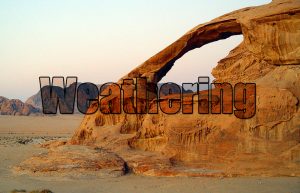
What Does Weathering Mean?
Weathering is breaking down rocks, soil, and minerals as well as wood and artificial materials by contacting the atmosphere, water, and biological organisms of the Earth. Weathering takes place in situ, i.e. in the same place, with little or no movement. It should therefore not be confused with erosion involving the movement of rocks and minerals by agents such as water, ice, snow, wind, waves and gravity, and then transported and deposited elsewhere.
There are two important weathering process classifications–physical and chemical weathering; each involves a biological component at times. Mechanical or physical weathering involves rock and soil breakdown by direct contact with atmospheric conditions such as heat, water, ice and pressure.
The second classification, chemical weathering, involves the direct effect in the breakdown of rocks, soils and minerals of atmospheric chemicals or biologically produced chemicals also known as biological weathering. While physical weathering is emphasized in very cold or very dry environments, where the climate is wet and hot, chemical reactions are most intense. Both types of weathering, however, take place together, and each tends to speed up the other.
How Rocks Are Weathered?
Once a rock is broken down, the bits of rock and mineral are carried away by a process called erosion. No rock on Earth is hard enough to resist weathering and erosion forces.
What are the 3 types of weathering?
Weathering is often divided into mechanical weathering and weathering processes. Biological weathering may be part of both processes, in which living or once – living organisms contribute to weathering.
Physical Weathering
Physical weathering, also known as mechanical weathering or disaggregation, is the process class that causes rocks to disintegrate without chemical change. Abrasion (the process by which clasts and other particles are reduced in size) is the primary process in physical weathering.
Due to temperature, pressure, frost etc., physical weather may occur. For instance, cracks exploited by physical weathering will increase the surface area that is exposed to chemical action, thereby increasing the rate of disintegration.
Where does Physical Weathering occur?
In places where there is little soil and few plants grow, such as mountain regions and hot deserts, physical weathering occurs especially.
How does Physical Weathering occur?
Either by repeated melting and freezing of water (mountains and tundra) or by expanding and shrinking the surface layer of rocks baked by the sun (hot deserts).
Chemical Weathering
Chemical weathering changes rock composition, often transforming them into different chemical reactions when water interacts with minerals. Chemical weathering is a gradual and ongoing process as the rock mineralogy adjusts to the environment near the surface.
The rock’s original minerals develop new or secondary minerals. The oxidation and hydrolysis processes are most important in this. Chemical weathering is enhanced by geological agents such as water and oxygen, as well as biological agents such as microbial and plant-root metabolism acids.
Where does Chemical Weathering occur?
These chemical processes require water and occur faster at higher temperatures, so it is best to have warm, humid climates. The first stage in soil production is chemical weathering (especially hydrolysis and oxidation).
How does Chemical Weathering occur?
There are various types of chemical weathering, the most important of which is:
Solution
Removal of rock by acidic rainwater in solution. In particular, dissolved CO2-containing rainwater (this process is sometimes referred to as carbonation) weathers calestone.
Hydrolysis
Acidic water breakdown of rock producing clay and soluble salts.
Oxidation
Rock breakdown by oxygen and water, often giving a rusty – colored weathered surface to iron – rich rocks.
Biological Weathering
Biological weathering is the weakening and subsequent breakdown by plants, animals and microbes of rock.
Growing roots of plants can put stress or pressure on rock. Even though the process is physical, a biological process (i.e. growing roots) exerts the pressure. Biological processes can also produce chemical weathering, such as when organic acids are produced by plant roots or microorganisms that help dissolve minerals.
Microbial activity breaks down rock minerals by altering the chemical composition of the rock, making it more weather sensitive. One example of microbial activity is lichen ; lichen is a symbiotic relationship between fungi and algae. Fungi release chemical substances that break down rock minerals ; the algae consume the minerals thus released from rock. Holes and gaps continue to develop on the rock as this process continues, exposing the rock to physical and chemical weathering.
Burrowing animals can move fragments of rock to the surface, exposing the rock to more intense chemical, physical, and biological processes, thereby indirectly enhancing the weathering process.
How Weathering Is Different From Erosion?
The main difference between weathering and erosion is that there is weathering whereas erosion involves moving to a new location. Both are caused by wind, water, ice, temperature, and even biological action similar factors. They can also take place together.










